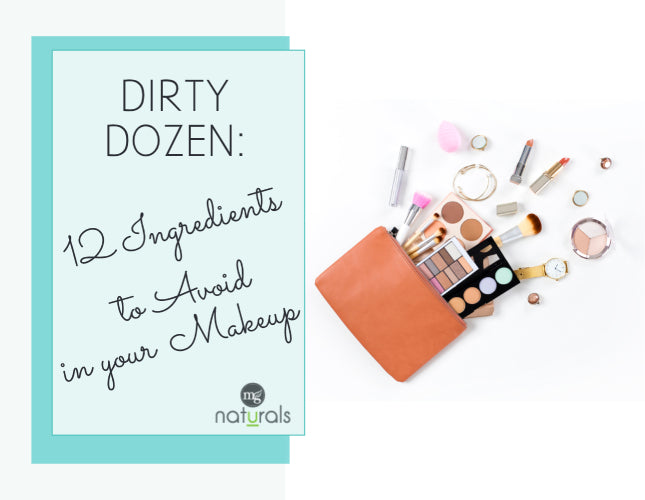Your Cart is Empty
FREE SHIPPINGAustralia $70+ International $180+



Did you know the chemicals that are used to keep concrete soft, degreasers that get grime off auto parts, and surfactants that reduce surface tension in water, like in paint and inks, can actually be found in your cosmetics?
Research shows that from the 82,000 ingredients used in personal care and cosmetic products, 1 in 8 are industrial chemicals, including carcinogens, pesticides, reproductive toxins, and hormone disruptors.
If you’re looking to detox your beauty bag, here is where you should start.
Look out for these nasty chemicals on your ingredient lists:
1. BHA and BHT
Used as preservatives in your lipsticks and moisturizers, BHA (or butylated hydroxyanisole) and BHT (butylated hydroxytoluene) can induce allergic reactions for your skin. The International Agency for Research on Cancer (IARC) classified BHA as a possible human carcinogen. While BHT was reported to cause liver damage and interfere with thyroid hormone levels.
2. Coal Tar Dyes
On your cosmetic labels, coal tar dyes are generally identified by a five-digit Colour Index (CI) number or labelled as P-phenylenediamine.These dyes are used as a colorant in mascaras, eyeshadows, and eyeliners. The IARC has identified coal tar dyes as a known human carcinogen that has been linked to brain damage.
3. DEA
Makes cosmetic products creamy or can be used as a pH balancer. DEA (diethanolamine) can be found in moisturizers, sunscreen, and facial cleansers. It is known to cause skin and eye irritation, and exposure to high doses of DEA has been linked to liver cancers and precancerous changes in skin and thyroid.
4. Dibutyl phthalate
Dibutyl phthalate (prouncedthal-ate), or DBP, is used mainly in nail polish, perfume, and your makeup remover as a common fragrance ingredient and solvent. Currently banned by the European Union, persistent use of DBP has been found to cause hormonal disruptions and developmental defects in fetuses.
5. Formaldehyde-releasing preservatives
Found in your blush, mascara, and makeup remover, this preservative has been classified as a known human carcinogen. Research shows that it can also irritate skin and eyes and trigger allergies at low doses. In your cosmetics, they are usually labeled as DMDM hydantoin, diazolidinyl urea, imidazolidinyl urea, methenamine, quaternium-15, and sodium hydroxymethylglycinate.
6. Parabens
Banned by the European Union. Paraben's are still the most widely used preservative in cosmetics. They are mostly used in your makeup to prevent contamination of products & ensuring shelf life. Paraben's have been associated with hormonal disruptions, breast cancer, increased skin ageing, and DNA damage.
7. Parfum/ Fragrance
You can usually spot this in your cosmetics labelled as “parfum” or “fragrance”, but these undisclosed fragrances are actually a complex mixture of dozens of chemicals. They are used in nearly every type of personal care product and yet no law requires companies to list the individual chemicals in their fragrance mixture. These unlisted ingredients can trigger allergies, migraines, and asthma symptoms, and have been linked to cancer and neurotoxicity.
8. Polyethylene / PEGs
PEGs (polyethylene glycols) are petroleum-based compounds used in cream bases for cosmetics as thickeners, solvents, softeners, and moisture-carriers. PEGs can cause irritation and systemic toxicity. Depending on the quality and manufacturing process PEG compounds can get contaminated with carcinogenic substances like ethylene oxide and 1,4-dioxane. They also function as “penetration enhancers” which increase the permeability of the skin. This allows potentially harmful ingredients to reach farther into the epidermis, breaking apart your natural lipid barrier.
9. Petrolatum / PAHs
Commonly used in moisturisers, lip balms, and lipsticks, this mineral oil jelly becomes a health hazard if not fully refined. Studies have shown that when contaminated with PAHs, Petrolatum may cause skin cancer. PAHs in petrolatum is also associated with skin irritation and allergies.
10. Siloxanes
Provides smoothness and that silky skin feeling in your foundations and moisturisers, these silicone-based compounds are toxic, endocrine disruptors, and interfere with human hormone function causing fertility issues. Siloxanes also have the potential to bioaccumulate in aquatic organisms.
11. Sodium laureth sulfate
Sodium laureth sulfate (SLES) is common in your bathroom products such ascleaning sprays, shampoos, shower gels and facial cleansers, but they are also found in your beauty bag, particularly in your lip balm, makeup remover, foundation, and sunscreen. SLES's have been identified to cause skin irritation and trigger dermatitis, as well as being a major disruptor to your skin microbiome. It's also considered to cause acne, particularly cystic acne.
12. Triclosan
This chemical which is often found in a wide range of household products, including garage bags, paints, and laundry detergent, are also commonly used as a preservative in water-based makeup formulations. However, it is found to irritate the skin and eyes, and may cause endocrine disruption. Triclosan is also identified as a chlorophenol, which is a cancer-causing chemical class.
Imagine all the harmful chemicals you’ve already put on your face unknowingly. Time to look through your beauty bag and hunt down these dirty dozen in your makeup’s ingredient list & get replacing them asap.
Because your skin & your health are worth it.